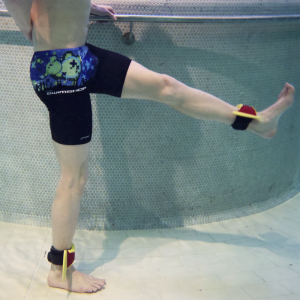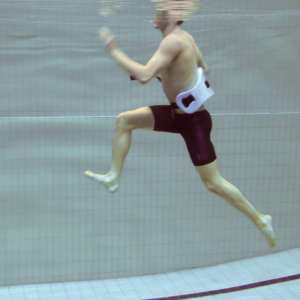Hydrotherapy is a great treatment option for people with OA knees, but what does exercise look like in the water? In this post we will examine the evidence base.
Knee osteoarthritis is characterized by the irreversible loss of articular cartilage from the condyles of the femur and the plateau of the tibia. As the damage progresses, the pain increases, which leads to a reduction in the quality of life.
As the symptoms progress, people with OA generally reduce their physical activity due to pain. Unfortunately, avoidance of activity leads to an accelerated progression of symptoms and a loss of functionality, while participation in the right kind of exercise actually improves and prevents symptoms.
Why do your knees creak?
Almost all guidelines list exercises on land as cornerstones for the non-surgical treatment of knee osteoarthritis. For some people, however, pain can prevent participation in a treatment program and a different approach is required.
This is where hydrotherapy comes into play, as it offers relieved training in a warm therapeutic environment. It has also been used for a long time and has been shown to be effective in treating knee OA, in part because of its perceived pain relieving effects during and immediately after exercise.
But what does a hydrotherapy exercise program look like in the treatment of knee OA?
Water aerobics for knee OA – The proof
In a systematic review by Waller et al. and Cochrane Review by Bartels et al. hydrotherapy has been shown to significantly improve pain in knee OA. Measurements of the physical function showed only a very small or no improvement, so what is going on?
Well the main explanation is that the intensity of the exercises chosen and the primary results were very different. All different types of exercises were thrown into exercise plans, which made it difficult to draw firm conclusions.
So we need to turn to RCTs and other study designs to figure out which exercises to use.
Transition from land to water exercises for knee OA
As with land exercises, the treatment plan should be tailored to the patient's needs and a good way to achieve this is to use the ICF. To be as effective as possible, the program should focus on one main objective and be carried out twice a week for between three and six months.
If you want to send ideas, pictures or videos of hydrotherapy exercises to your patients then take a look at a Physioplus PRO account which includes a telemedicine platform. First, let's break things down into 4 different exercise groups:
Flexibility and ROM
Water resistance training
Cardiovascular system
Neuromuscular and Balance
Flexibility and shared ROM
Static stretching in warm water is easier than on land. A good tip here is to use the buoyancy of the water with floats to support the stretching and to enable the patient to “relax” into the stretching.
In addition, it appears that the muscle spindle activation decreases during passive immersion this, in combination with less pain, enables more effective passive soft tissue expansion.
Stick to cell biology – the active movements in warm water also increase cell activity in the fascia, which further improves the mobility of soft tissues and joints, and this largely explains the short-term pain and mobility increases reported in the evidence.
Water resistance training

The regulation of strength training should always be based on a maximum of 1 repetition. Low intensity strength training includes 10-15 reps at 40% of the 1RM, moderate 6-10 reps at 40-60% of the 1RM, and high is 6-8 reps> 60% of the 1RM. But is that also the case in the water?
It is a bit difficult to measure muscle activity exactly as it is on land, because water dynamics and gravity do not act on the muscles in the same way . Therefore, a repetition of an exercise between two people exerts a different force.
One method of controlling resistance during water resistance training is to use equipment that increases the surface area of the limb. The most common example is a resistance boot, which can increase the resistance by a factor of three when moving under water.
In general, programs that include 5-6 water resistance exercises for the lower extremities that focus on the knees and hips have proven to be most effective. Try to do each exercise for 30-60 seconds, each rep being as hard and fast as possible.
Each leg should be trained consecutively without a break, followed by a 30-45 second break with 2-4 sets per exercise, with a 1 minute break between each exercise. Overall, the main part of the session should last around 30-40, with a 10-15 minute warm up and cool down to round off an hour.
Cardiovascular fitness
